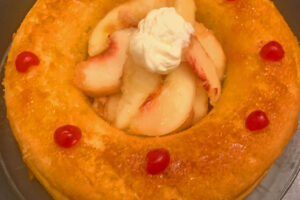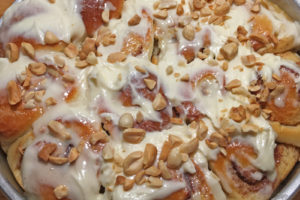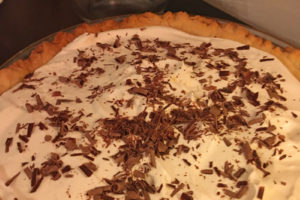Nowadays high-quality raised donuts are not difficult to find. However, I find that quality cake donuts are quite another matter—thus my Buttermilk Cake Donuts recipe. They are really not that difficult to make, but they do take time because the dough must be refrigerated for at least several hours.
I began developing this recipe using James Beard’s cake donut recipe. I believe that almost all pastries that use milk are improved by using buttermilk. It just seems to make them richer, moister, and more tender. Adding buttermilk was just the beginning of changes that I made to Beard’s excellent recipe. The buttermilk of course requires the addition of baking soda, and I increased the amount of butter and mace used, as well as added some nutmeg. For a history of cake vs. raised donuts, click here.
To Download or Print the Full Recipe, Click Here.
For the Donuts
Make certain the butter, eggs, and buttermilk are at room temperature. If you can find Five Acre Buttermilk, by all means buy it.

I highly recommend this whole-milk product because it is incredibly thick and rich.
In a large bowl, whisk together the flour, baking powder, baking soda, salt, mace, and nutmeg until well combined.

Mix the dry ingredients.
One of the main lacks in commercial cake donuts is they don’t use mace (the outer webbing of a nutmeg seed), which is an essential flavor of the cake donut, probably because it’s rather expensive. Here is some background on mace. If you decide not to use it, increase the amount of nutmeg—though you will be missing out on a wonderful flavor.
In a mixer, cream the butter, and gradually add the sugar, beating until very fluffy and airy.

Cream the butter and sugar.
Beat in the eggs one at a time.

Add the eggs.
On low speed, gradually add the dry ingredients to the creamed mixture, alternating with the buttermilk, and finishing with the dry ingredients.

Add the buttermilk.
The dough should begin to form a mass.

Finish mixing the dough.
Once the dough has come together, cover the bowl with plastic and chill it in the refrigerator for several hours, or preferably overnight. The dough will be sticky.
In a large fry pan, pour at least 1-inch of vegetable oil, and heat it to 370°. I like to use an electric fry pan for donuts because you can control the heat, which is very important. You should keep the oil at 360° to 375° at all times during the frying. Use a thermometer if you don’t have an electric fry pan. The oil should be heated to the proper temperature before you begin rolling the dough, or you will make the mistake I once made of waiting around for the oil to heat and finding the donuts had become to soft to handle.
When the oil has reached the proper temperature, generously flour a board, the rolling pin, and the donut cutter. The dough remains quite sticky, so you must flour all the equipment. Remove half of the dough from the refrigerator, and place it on the floured board. Sprinkle a tiny bit of flour to help make the rolling easier. Quickly roll out the dough to a 1⁄2-inch thickness.
Cut out the donuts with a donut cutter.

Cut with a donut cutter.
If you don’t have a donut cutter, use a biscuit cutter and a small cutter. The donuts must have the holes cut out or the centers will be under cooked.

Cut the donuts and holes.
With a floured spatula, place the donuts (no more than fit comfortably in the pan) in the hot fat. In 1-2 minutes the donuts will rise to the surface, and be lightly browned on the bottom.

Fry the first side.
Flip the donuts with the spatula and a knife, and brown the other side lightly, generally about a minute or so.

Flip the donuts.
Drain the donuts thoroughly on paper towels.
The remaining dough can be reformed and rolled out again, though they often don’t look as perfect. Cut out the donuts and fry, along with the donut holes.

Fry the donut holes.
You can then repeat the process with the remaining refrigerated dough, or you can leave it in the refrigerator, and fry it another day. It keep well under refrigeration for several days.
When the donuts are completely cooled and dried free of oil, sprinkle them with powdered sugar or granulated cinnamon sugar—the simplest and most delicious coatings.
For the Chocolate Icing
In a bowl, sift together the powdered sugar and the cocoa, then whisk in the salt. In a small pan, heat the heavy cream to the boiling point. Begin pouring the cream into the sugar/cocoa mixture—along with the corn syrup and the vanilla—using only as much cream as necessary to make a spreadable icing. Continue beating the icing until it is very smooth. Spread the icing over the top of the donuts with a butter knife. This seems to work better than dipping them in the chocolate. I’ve grown especially fond of dipping the bottom of the Buttermilk Cake Donuts in cinnamon sugar, then coating the top with the chocolate icing.
Although Buttermilk Cake Donuts, do not stay fresh for more than a day or so, you can freeze any leftover cooked donuts.





